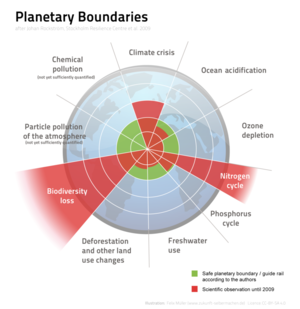Ecological crisis
In the 1960s, humans took about three-quarters of what the planet could regenerate annually.[1] By 2016 this rose to 170 percent. The planet cannot keep up with current human demand and time is running out to curtail growth.[2]

The world won't end tomorrow, next year or the year after. But 97% of scientists (i.e. 100% minus the lobbyists) predict it will get progressively worse. Each day we do nothing we are rolling a dice where the probability of something seriously bad happening increases. We have already seen:
- Climate change - since records began in 1880, nineteen of the twenty hottest years have occurred since 2000[3].
- Biodiversity loss - there has been a 68% average decline in the population sizes of mammals, birds, amphibians, reptiles, and fish between 1970 and 2016[4].
- Deforestation - more than half the world’s tropical forests have been destroyed since the 1960s[5].
- Ocean acidification - more CO2 in the atmosphere means more acidity in the oceans.
- Microplastics via overconsumption - humanity is running an ecological Ponzi scheme in which society robs nature and future generations to pay for boosting incomes in the short term.[2]
- Ozone depletion, the nitrogen cycle, the phosphorus cycle...
These issues combined are accelerating us towards collapse.
Root Cause
There is merit treating each boundary by divesting from fossil fuels, investing in renewables or reducing plastic use however it does not address the root cause. Like a doctor treating the symptoms of a cancer instead of treating the cancer itself, perhaps symptom management placates the anxiety we feel that something a lot deeper is wrong with the system.
By 2100 these locations will be uninhabitable...[6]
The most impoverished areas will be effected the most, notably starvation in India and Sub-Saharan Africa. However, the most well off areas are not immune with water shortages due on the West Coast of the US and flooding of the islands of Southeast Asia. You can delve further into these predictions here.
References
- ↑ 1.0 1.1 https://www.frontiersin.org/articles/10.3389/fcosc.2020.615419/full
- ↑ 2.0 2.1 Yale Environment 360: Avoiding a ‘Ghastly Future’: Hard Truths on the State of the Planet. Accessed on 3rd March 2022 via:https://e360.yale.edu/features/avoiding-a-ghastly-future-hard-truths-on-the-state-of-the-planet
- ↑ NASA, Global Temperature: https://climate.nasa.gov/vital-signs/global-temperature/
- ↑ IPBES, Media Release, Nature’s Dangerous Decline ‘Unprecedented’; Species Extinction Rates ‘Accelerating’ May 2019
- ↑ International Union for Conservation of Nature. (2021, February). Deforestation and forest degradation. https://www.iucn.org/resources/issues-briefs/deforestation-and-forest-degradation
- ↑ https://interaktiv.morgenpost.de/klimawandel-hitze-meeresspiegel-wassermangel-stuerme-unbewohnbar/en.html